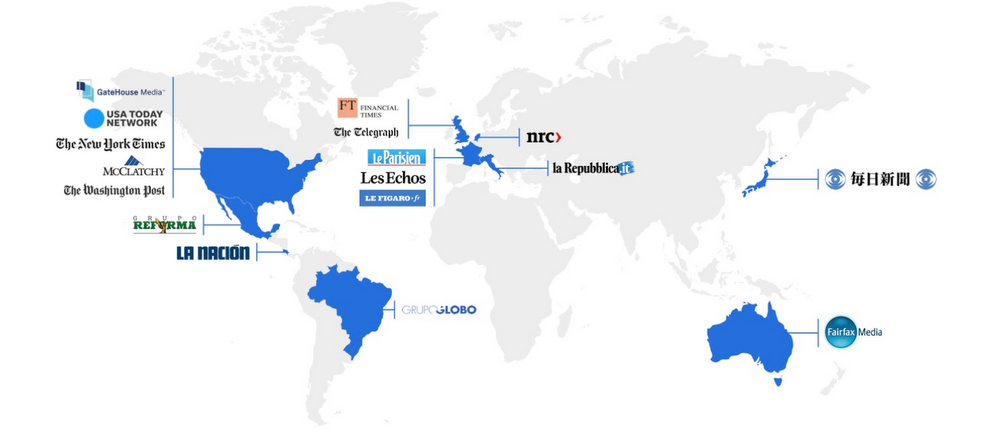On March 21, Google announced the Google News Initiative. Google says the announcement is “part of an effort to contribute to the digital era of journalism.” According to Google, Google is collaborating with the media industry, including Accelerated Mobile Pages (AMP) for open source mobile optimization pages, YouTube players for easy video distribution, Flexible Sampling for search of news content in Google, The Google News Lab for partnerships, and the Digital News Initiative for European media innovation.

Google also supported $ 12.6 billion for its media partners last year and emphasized that it provided free traffic to its media websites for 10 billion per month. The Google News Initiative, released this week, says Google plans to bring together products and partnerships for the future of the news. The Google News Initiative focuses on three areas: strengthening high-quality journalism, evolving the media business model, and enhancing media innovation capabilities.
Here, the subscription model, Subscribe with Google, which is a product that can diversify the income sources of the media, attracts attention (though it may be a market that is actually collapsed in Korea). It’s a subscription platform that Google has introduced. Google says it is trying to change the subscription process so that more readers can quickly consume journalism content.

With the advent of the Internet, a lot of news sites have popped up. In the domestic market, there are very few, but overseas have adopted a billing model that generates a monthly payment. The problem is that you have to go through various processes for ID and billing at numerous sites. Of course it is difficult to manage. Google’s subscription service allows you to sign in to your site using your Google account and process your payments as Google Pay, making it easier for you to sign up and manage your news site.
Because Google’s subscription service uses a Google account, if you have a paid news site, you do not need to create an account for each site if you choose only the billing type, such as monthly or annual payments. Payments can be processed with Google Pay, as mentioned above, so you do not need to enter credit card information for each site. You can end the subscription process with just a few tabs. This allows you to keep reading your favorite articles without having to go to another page.
Another advantage is that you can access the same information from other devices simply by logging into your Google account. And because it will also display subscription pages in Google’s search results, it will also make Google more accessible to high-quality articles.

Of course, as I mentioned earlier, the impact of the program on our country may not be significant. In fact, Google’s subscription service started in North America and parts of South America, Europe and Australia, and Japan is the only one in Asia. In the United States, the New York Times, USA Today, and Washington Post participated, and the UK Financial Times, the Telegraph and the Japan Mainichi Newspaper.
In Korea, such as out-standing sites are attempting a paid-up model. Out Standing began its paid service in 2016. According to Outstanding Standing, which celebrates its first anniversary in 2017, the total number of payments is 4,000 and half of these subscribers are subscribers. Out Standing’s premium membership structure is 9,900 won per month, and the annual payment is 118,800 won. If you look at this in half, you can estimate that you have earned more than 230 million won in subscription revenue a year.
If you have a media company that wants to run such a subscription model, you do not need to build your own infrastructure and you might be able to help with subscription demand research. Google is also testing subscription intentions based on the machine learning model using a double click infrastructure. You want to know your audience.
Another advantage is that it allows you to identify subscriptions through News Consumer Insights, a dashboard based on Google Analytics. For example, in the case of Google dispatch, the project was run on the St. Louis dispatch, with a 150% increase in subscription page views and a threefold increase in subscriptions.
It is clear that the subscription model is one of the paid – up models that interest the media. A lot of attempts are being made overseas. Services like Blendle ( https://launch.blendle.com ) are one such example. As Google’s subscription service is launched in Europe and North America, Blen is also the first successful billing platform in Europe to be served through iOS and Android.
Blenns is a Dutch start-up that started service in 2014. Newspaper magazine articles published on the Internet are served as content, priced between 10 cents and 80 cents per piece. In addition, after receiving $ 3.8 million from German media companies such as Axel Springer and the New York Times, the company entered the Netherlands in 2016 and entered the United States.
In the case of Blenn, newspapers and magazines can be purchased per article, and advertisements are not posted because they are paid. If you are not satisfied with the contents of the article, you can also process the return.
The paid-for-profit model, like Blenheim, may provide a way for readers to change the way they approach content. Of course, this can also be true of Google’s subscription service. Companies like Google are also able to strengthen their platform dominance.
Of course, this might be a good thing for a media company that is having trouble making money, but it might come to the question why YouTube has made an ad if it is a brand new. Yutube’s delicious Sound of Delicious Shin Ramyun is currently recording more than 5 million views. Based on the results of Google Big Data and research, I presented the advertisement. Anyway, the core model for YouTube is platform based advertising and paid services such as YouTube Red. Advertising video production itself is not a core business. It is necessary to remember that “when your core business becomes a complement to someone else, it is time to get upset” as it is in the article.
Of course, domestic is more negative perception of paid models than overseas (for various reasons). In fact, it may be one of the examples of existing media companies that will tell you that their business core model is a complement to the platform (now Naver dependent). On the other hand, as an example of outstandings, it may be a way to raise potential for new media. Also, there is no way to provide a subscription model and not provide crowdfunding.
I’m not saying that the Google subscription model will succeed. However, it is not the know-how, but the age of know-where. It is important to remember that in this age of technological innovation, it is important to know and use technology well. The platform is increasingly becoming a big brother and the media is heading in the opposite direction. You should be able to use it better than you develop and make it yourself. Anyway, the model of this kind of platform might be able to transform the existing content production terrain into an open market where one person can enter without barriers in the long run. “You only make content.”


















Add comment